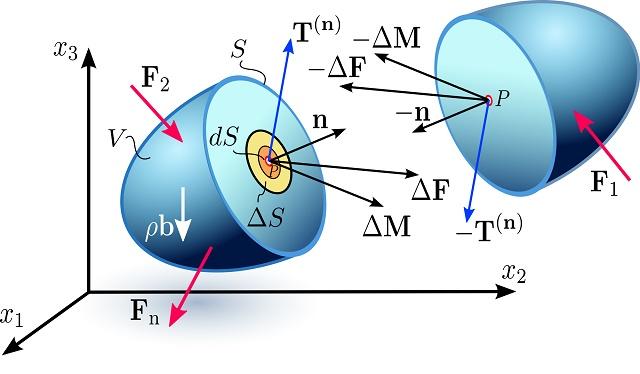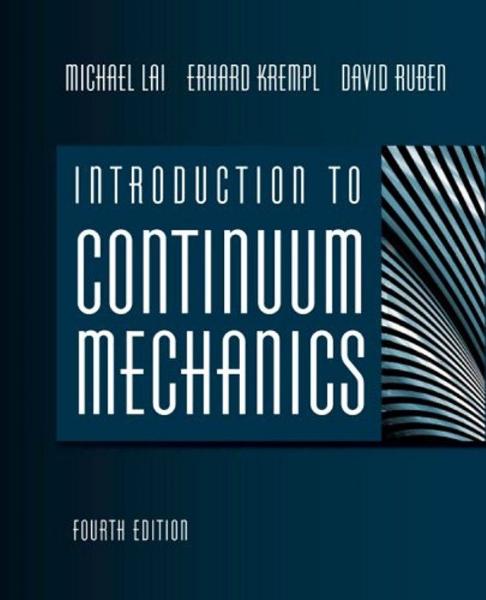مکانیک محیط های پیوسته، یک شاخه وسیع از مکانیک محسوب می شود. هدف این شاخه علمی، فراگیری این واقعیت است که چگونه مسائل مربوط به حرکت اجسام شکل پذیر (جامد، مایع و گاز) صورت بندی و سئوالات و ایده های کلی و حتی مبهم به عبارات دقیق ریاضی بدل شوند. در زمینه مکانیک محیط های پیوسته، کتب متعددی تدوین شده است. کتاب مقدمه ای بر مکانیک محیط های پیوسته (مایکل لی، دیوید رابین، ارهارد کرمپل) به دو دلیل زیر به شما علاقمندان پیشنهاد می گردد:
نخست اینکه سادگی در بیان مطالب، تقسیم بندی مناسب موضوعات، ارائه مثال های متعدد برای تفهیم مطلب و گردآوری مسائل زیاد در انتهای هر فصل، کتاب را برای کلاس درس کاملا مناسب نموده است. دوم اینکه با توجه به معرفی تانسورهای مرتبه دو از طریق تشریح تبدیلات خطی، به فهم مبادی ریاضی متن که یکی از پیچیدگی های مکانیک محیط های پیوسته محسوب می شود، سادگی و سهولت خاصی بخشیده است...
نمونه سوالات امتحانی پایان ترم دروس کارشناسی ارشد مهندسی مکانیک
مجموعه آموزشی مکانیک محیط های پیوسته به همراه تشریح کامل مسائل
مجموعه جزوات کارشناسی ارشد مهندسی مکانیک

کتاب مقدمه ای بر مکانیک محیط های پیوسته، یکی از کتاب های مرجع و کاربردی در زمینه مکانیک محیط های پیوسته است که در اکثر دانشگاه های ایران تدریس می گردد. در این مجموعه آموزشی شما قادر خواهید بود اولا نسخه اصلی کتاب به زبان لاتین (Introduction to Continuum Mechanics)، ثانیا نسخه ترجمه شده این کتاب به زبان فارسی (مترجم دکتر غلامحسین رحیمی)، ثالثا تشریح کامل مسائل این کتاب را بطور کامل دانلود نمایید.

این کتاب مشتمل بر 375 صفحه، در 8 فصل، با فرمت PDF، به زبان فارسی، همراه با مسائل به ترتیب زیر گردآوری شده است:
فصل 1: مقدمه
- نظریه محیط پیوسته
- محتوای مکانیک محیط های پیوسته
فصل 2: نمادگذاری شاخصی و تانسورها
- قرارداد جمع، شاخص های کاذب
- شاخص های آزاد
- دلتای کرانکر
- نماد جایگشت
- عملیات با نمادگذاری شاخصی
- تانسور، یک تبدیل خطی
- مولفه های یک تانسور
- جمع تانسور
- حاصلضرب دیادیک
- ضرب دو تانسور
- تانسور واحد
- برگردان یک تانسور
- تانسور متعامد
- قوانین تبدیل برای مولفه های دکارتی تانسورها و بردارها
- تانسورهای متقارن و پادمتقارن
- بردار دوگان یک تانسور پادمتقارن
- مقادیر ویژه و بردارهای ویژه یک تانسور
- مقادیر اصلی و جهات اصلی تانسورهای متقارن حقیقی
- ماتریس یک تانسور نسبت به جهات اصلی
- پایاهای عددی یک تانسور
- توابع با ارزش تانسوری یک عددی
- میدان عددی، گرادیان یک تابع عددی
- میدان برداری، گرادیان یک تابع برداری
- اثر یک تانسور مرتبه دو
- دیورژانس یک میدان برداری و دیورژانس یک میدان تانسوری
- کرل یک میدان برداری
- مختصات قطبی
- مسائل
فصل 3: سینماتیک محیط های پیوسته
- توصیف حرکت یک محیط پیوسته
- توصیف مادی و توصیف فضایی
- مشتق مادی
- یافتن شتاب یک ذره از یک میدان سرعت داده شده
- تغیر شکل
- کرنش اصلی
- اتساع
- نرخ تغیر شکل
- معادله بقای جرم
- شرایط سازگاری برای مولفه های بی نهایت کوچک کرنش
- شرایط سازگاری برای مولفه های نرخ تغییر شکل
- مسائل
فصل 4: تنش
- بردار تنش
- تانسور تنش
- مولفه های تانسور تنش
- تقارن تانسور تنش، اصل ممان اندازه حرکت
- تنش های اصلی
- تنش برشی حداکثر
- معادلات حرکت، اصل اندازه حرکت خطی
- شرط مرزی برای تانسور تنش
- مسائل
فصل 5: جامد الاستیک خطی
- خواص مکانیکی
- جامد الاستیک خطی
- جامد الاستیک همسانگرد خطی
- مدول یانگ، ضریب پواسون، مدول برشی و مدول حجمی
- معادلات نظریه بی نهایت کوچک الاستیسیته
- اصل جمع آثار
- مثال های از الاستو دینامیک
- موج غیر چرخشی مسطح
- موج هم حجم مسطح
- انعکاس امواج الاستیک مسطح
- ارتعاش یک ورق بی نهایت
- مثال هایی از الاستو استاتیک
- کشش ساده
- پیچش یک استوانه مدور
- پیچش یک استوانه غیر مدور
- خمش خالص یک تیر
- کرنش مسطح
- مسائل
فصل 6: سیال چسبنده نیوتنی
- سیالات
- سیالات تراکم پذیر و تراکم ناپذیر
- معادلات هیدرو استاتیک
- سیال نیوتنی
- تفسیر لاندا و مو
- سیال نیوتنی تراکم ناپذیر
- شرایط مرزی
- خط جریان، خط مسیر، جریان پایدار و ناپایدار، جریان لایه لایه و مغشوش
- مثال های از جریان های لایه لایه یک سیال نیوتنی تراکم ناپذیر
- جریان کوئت مسطح
- جریان پوسله مسطح
- جریان هاگن پوسوله
- جریان کوئت مسطج از دو لایه سیال تراکم ناپذیر
- جریان کوئت
- جریان نزدیک یک ورق مرتعش
- نرخ کار انجام شده روی یک ذره
- نرخ سیلان حرارت به داخل یک المان
- معادله انرژی
- بردار چرخش
- جریان غیر چرخشی
- جریان غیر چرخشی یک سیال تراکم ناپذیر غیر چسبنده با چگالی همگن
- جریان های غیر چرخشی به عنوان حلی برای معادله ناویر استوکس
- معادله انتقال چرخش برای سیال چسبنده تراکم ناپذیر با چگالی ثابت
- مفهوم لایه مرزی
- سیال نیوتنی تراکم پذیر
- معادله انرزی بر حسب آنتالپی
- موج صوتی
- جریان های باروتروپیک و غیر چرخشی سیال تراکم پذیر غیر چسبنده
- جریان یک بعدی یک سیال تراکم پذیر
- مسائل
فصل 7: فرمول بندی انتگرالی اصول عمومی
- قضیه گرین
- قضیه دیورژانس
- انتگرال روی یک حجم کنترل و انتگرال روی یک سطح مادی
- اصل بقای جرم
- اصل مقدار حرکت خطی
- پیرامون حجم کنترل متحرک
- اصل ممان اندازه حرکت
- اصل بقای انرژی
- مسائل
فصل 8: سیال ساده تراکم ناپذیر
- هیات جاری، به عنوان هیات مرجع
- تانسور تغییر شکل نسبی
- تانسور سابقه تغییر شکل، تانسورهای رولین اریکسن
- سیال ساده تراکم ناپذیر
- سیال رولین اریکسن
- جریان های ویسکومتر یک سیال ساده تراکم ناپذیر
- تنش ها در جریان ویسکومتر یک سیال ساده تراکم ناپذیر
- جریان های برشی ساده
- جریان در کنال
- مسائل
مقدمه ای بر مکانیک محیط های پیوسته
تانسورها - ریاضیات نظریه نسبیت و مکانیک پیوسته

کتاب مقدمه ای بر مکانیک محیط های پیوسته (Introduction to Continuum Mechanics)، مشتمل بر 536 صفحه، در 8 فصل، با فرمت PDF، به زبان انگلیسی، همراه با مسائل به ترتیب زیر گردآوری شده است:
- Chapter 1: Introduction
- Chapter 2: Tensors
- Chapter 3: Kinematics of a Continuum
- Chapter 4: Stress and Integral Formulations of General Principles
- Chapter 5: The Elastic Solid
- Chapter 6: Newtonian Viscous Fluid
- Chapter 7: The Reynolds Transport Theorem and Applications
- Chapter 8: Non-Newtonian Fluids

کتاب تشریح کامل مسائل مقدمه ای بر مکانیک محیط های پیوسته، مشتمل بر 246 صفحه، با فرمت PDF، به زبان انگلیسی، کلیه مسائل کتاب بالا (Introduction to Continuum Mechanics) را بطور کامل تشریح نموده است.

جهت دانلود مجموعه آموزشی مکانیک محیط های پیوسته به همراه تشریح کامل مسائل، بر لینک زیر کلیک نمایید.
مقدمه ای بر مکانیک محیط های پیوسته به همراه تشریح کامل مسائل
اگر به فراگیری مباحث مشابه مطلب بالا علاقهمند هستید، آموزشهایی که در ادامه آمدهاند نیز به شما پیشنهاد میشوند:
مدلسازی رفتار غیرالاستیک نانوتیوب های کربنی توسط مکانیک محیط پیوسته
نمونه سوالات امتحانی و تمرینات حل شده مکانیک محیط های پیوسته
شبیه سازی و تجزیه تحلیل ضربه بالستیک با استفاده از مدل مکانیک آسیب پیوسته
شبیه سازی کوره های قوس الکتریکی با استفاده از نرم افزار متلب
دیکشنری تخصصی مهندسی مواد
کامپوزیت های زمینه پلیمری
بهینه سازی اتصالات چسبی در کامپوزیت ها
پلاستیک های تقویت شده به انضمام جزوات کاربردی کامپوزیت ها
بررسی سرامیک ها و اهمیت اتصال در آنها



